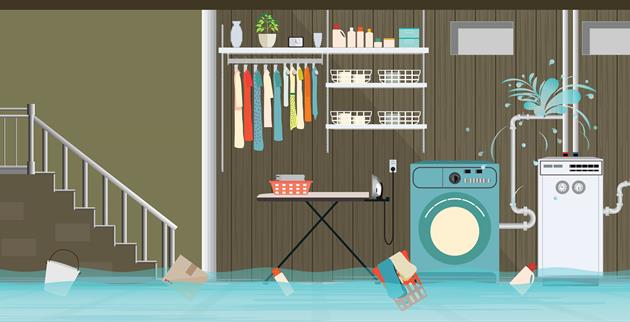Flooded Basement? Common Causes and Prevention Tips


Our Preferred Mutual Claims team put together a list of common causes of flooding they’ve seen and ways to prevent them.
Unexpected water in your basement can damage walls, floors and carpeting, and ruin furniture. It can also lead to mold! Read on for causes and how to prevent damage!
Basements are often used for storage, in addition to extra living space, so while water damage to your floors, walls and furniture can be upsetting, the most upsetting of all might be how a wet basement can also ruin irreplaceable items like photo albums, antiques and family heirlooms!
Our Preferred Mutual Claims team put together a list of common causes of flooding they’ve seen and ways to prevent them.
First things first
Don’t risk serious injury if your basement floods! A flooded basement can be a serious health and safety risk. If your basement floods, follow these rules to make sure your family stays safe.
Avoid venturing down into the basement if possible.
In the event of severe basement flooding (over an inch or more of standing water), it’s best to stay out of the basement until the water can be pumped out. Standing water in your basement can contain harmful bacteria.
Shut the power off, including electricity and gas.
If you must venture down into a flood basement, wear waterproof rubber boots. Avoid touching or using electrical devices (except for a battery-powered flashlight) because this puts you at risk of electrical shock.
Have standing water pumped out as soon as possible!
A professional should pump standing water out of your basement, and can help you handle water-damaged items and materials as well.
Determine the cause of your flooded basement
When you experience a flooded basement, our Customer Service team urges you to determine where the water is coming from first.
Beyond observable flooding around your home and in your neighborhood, there are four common sources of water entering basements:
- Surface water running down foundation walls.
- Groundwater in water-saturated soils being pushed into the basement.
- Storm sewer water from the municipal sewer system backing up into the home’s perimeter foundation drain and leaking into the basement.
- Sanitary sewer water from a clog in your home’s sewer line, the municipal sewer line, or the combined systems backing up into the drain system, causing sewer water to come up through sink drains and floor drains on lower levels.
Here are some things to look for in and outside of your home:
Overflowing gutters: Leaves and downspouts
Keeping gutters clean and the downspouts extended at least 10 feet from your home, you’ll save yourself a lot of headache!
Solution: Add another downspout on that run of gutter or increase the size of the downspout.
Water takes the path of least resistance
Often, if you have cracks in the walls, floors, foundation or windows, water will finds its way through them and into your basement.
Solution: Seal every crack you can find!
Clogging of sewer drains
Many times, the wrong items make it down the toilet. This will lead to sewer drain clog that can eventually lead to basement flooding.
Solution: Keep your toilet bowl and its plumbing free from debris like napkins, dental floss, or cotton swabs! This also means keeping your children from making the mistake of flushing toys and other items down, too!
If you are hoping your insurance company will cover damage to your wood-framed walls, drywall, flooring, or items lost to water damage, think again. Insurance to protect against flood loss almost always has to be purchased under a separate policy. Be sure to talk to an independent agent today to discuss the risk of your home to flooding events! Find your independent agent today!